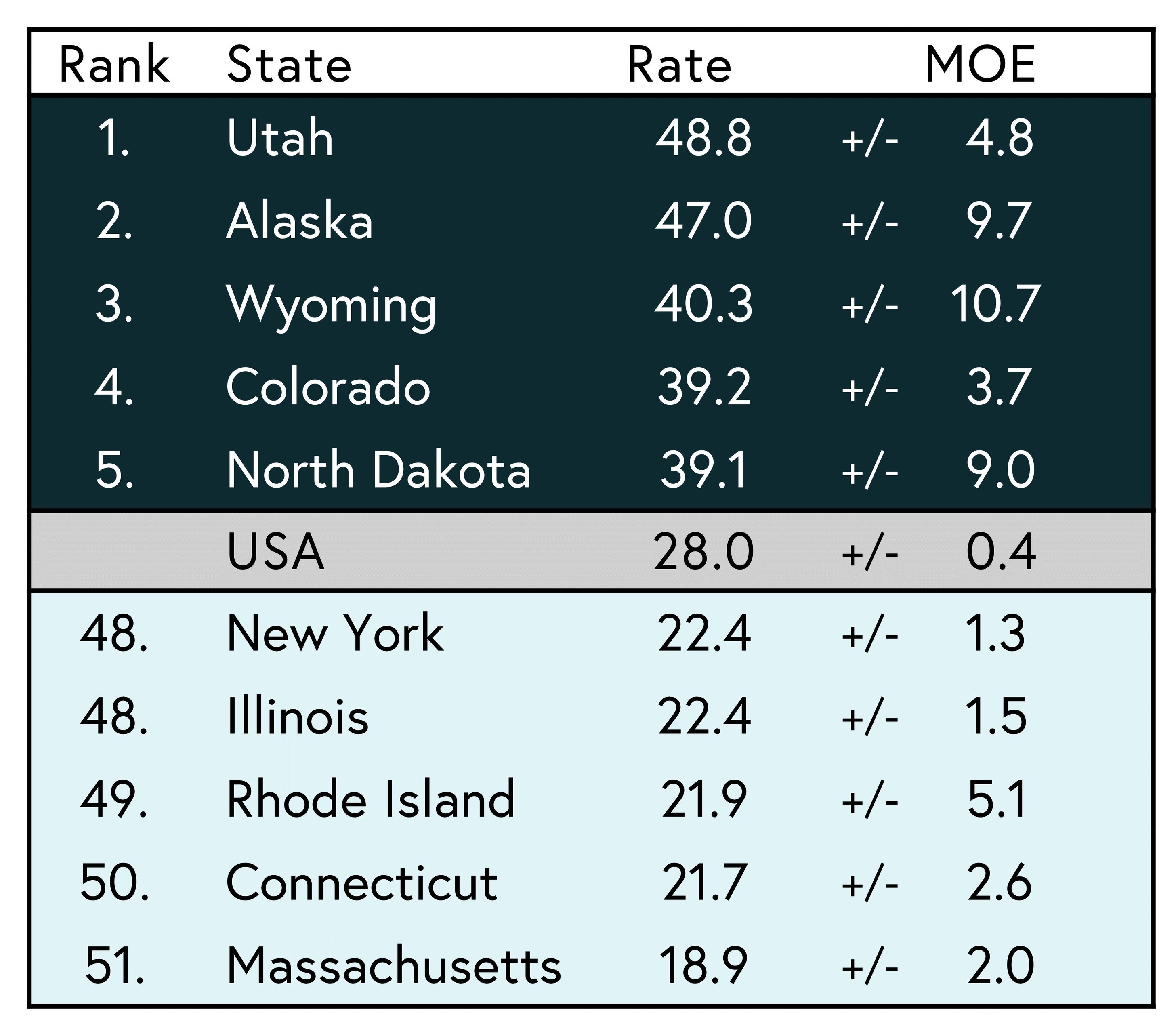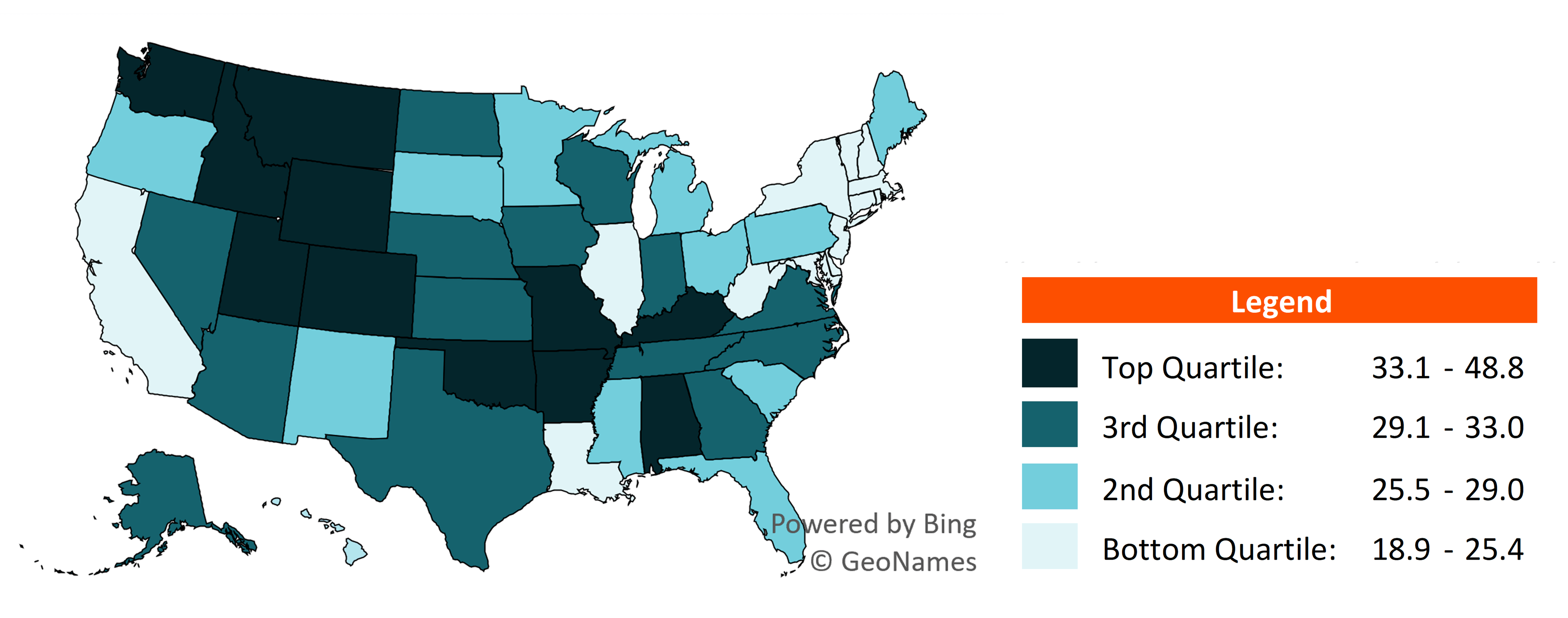Marriage Rate in the U.S.: Geographic Variation, 2021
Family Profile No. 25, 2022
Author: Gabrielle Juteau
This Family Profile, an update of previous profiles on the marriage rate (Hemez, 2016; Schweizer, 2018; Allred, 2019; Reynolds, 2020; Westrick-Payne, 2022), estimates adjusted marriage rates for the U.S. and each state for 2021. Using American Community Survey (ACS) data, we estimate the number of marriages occurring in the last year among unmarried women, calculate the margins of error, and describe geographic variation. For detailed information on the adjusted marriage rate from 2008-2020, see “Charting Marriage & Divorce in the U.S.: The Adjusted Marriage Rate” (Westrick-Payne, 2022).
U.S. Adjusted Marriage Rate, 2021
- After the marriage rate hit a 50-year low in 2020 (i.e., 28.1 marriages per 1,000 unmarried women), the marriage rate dropped slightly lower in 2021 to 28.0 marriages per 1,000 unmarried women.
- More than 2 million women (2,052,806) married in 2021.
Figure 1. Women’s Adjusted Marriage Rate, 1970-2021

Five Highest and Lowest Marriage Rates, 2021
- Utah once again holds the top spot in terms of the marriage rate with nearly 49 marriages per 1,000 unmarried women in 2021.
- Massachusetts now holds the lowest marriage rate. In 2021, nearly 19 women married per 1,000 unmarried women in Massachusetts, representing about 2.5 times fewer marriages than among those living in Utah
Figure 2. Women's Highest and Lowest Adjusted Marriage Rates, 2021

State Rankings and Geographic Variation in Marriage Rates, 2021
- The states with the highest marriage rates (making up the top/ fourth quartile) in 2021 had rates of at least 33.1 marriages per 1,000 unmarried women aged 15 and older. Among the states in the top quartile, all are substantially above the national average (28 marriages per 1,000 unmarried women).
- The states with the lowest marriage rates (making up the first/ bottom quartile) in 2021 had 21.4 or fewer marriages per 1,000 unmarried women.
Figure 3. State-Level Women’s Adjusted Marriage Rate by Quartile, 2021

- Most states in the Western region of the country had high marriages rates (third or fourth quartile).
- Exceptions included New Mexico, California, Hawaii, Oregon, and Arizona.
- Midwestern states exhibited marriage rates predominately in the middle two quartiles with the largest share found in the second quartile.
- Illinois was the only midwestern state found in the first/ bottom quartile.
- Missouri was the only midwestern state found in the fourth/ top quartile.
- Southern states are represented in each quartile. The largest shares were found in the third and fourth.
- Nearly all states in the Northeast exhibited low marriage rates (first quartile).
- Exceptions included Pennsylvania and Maine (second quartile).
Figure 4. Geographic Variation of Women’s Adjusted Marriage Rate Among States, 2021

Data Sources:
Clarke. S. C. (1995). Advanced report of final marriage statistics, 1989 and 1990. Monthly Vital Statistics Report, 42(12). National Center for Health Statistics. https://www.cdc.gov/nchs/data/mvsr/mv43_12.pdf
National Center for Health Statistics (1974). Summary report final marriage statistics, 1970. Monthly Vital Statistics Report, 23(2), Supp.1. U.S. Department of Health, Education, and Welfare. https://www.cdc.gov/nchs/data/mvsr/supp/mv23_02s1acc.pdf
National Center for Health Statistics (1983). Advance report of final marriage statistics, 1980. Monthly Vital Statistics Report, 32(5), Supp. U.S. Department of Health and Human Services. https://www.cdc.gov/nchs/data/mvsr/supp/mv32_05s.pdf
National Center for Health Statistics (2001). Births, marriages, divorces, and deaths: Provisional data for January-December 2000. National Vital Statistics Report, 49(6), Associated Table 3. Department of Health & Human Services, Center for Disease Control and Prevention. https://www.cdc.gov/nchs/data/nvsr/nvsr49/nvsr49_06.pdf
U.S. Census Bureau (2022). American Community Survey, 2021 1-Year Estimates [Table B12001]. Retrieved from: https://data.census.gov/cedsci/table?q=B12001&tid=ACSDT1Y2021.B12001
U.S. Census Bureau (2022). American Community Survey, 2021 1-Year Estimates [Table B12501]. Retrieved from: https://data.census.gov/cedsci/table?q=B12501&tid=ACSDT1Y2021.B12501
U.S. Census Bureau (2021). American Community Survey, 2020 1-year Experimental PUMS
References:
Allred, C. (2019). Marriage rate in the U.S.: Geographic variation, 2018. Family Profiles, FP-19-22. Bowling Green, OH: National Center for Family & Marriage Research. https://doi.org/10.25035/ncfmr/fp-19-22
Hemez, P. (2017). Marriage rate in the U.S.: Geographic variation, 2016. Family Profiles, FP-17-25. Bowling Green, OH: National Center for Family & Marriage Research. https://doi.org/10.25035/ncfmr/fp-17-25
Reynolds, L (2020). Marriage rate in the U.S.: Geographic variation, 2019. Family Profiles, FP-20-24. Bowling Green, OH: National Center for Family Marriage Research. https://doi.org/10.25035/ncfmr/fp-20-24
Schweizer, V. J. (2018). Marriage rate in the U.S.: Geographic variation, 2017. Family Profiles, FP-18-20. Bowling Green, OH: National Center for Family Marriage Research. https://doi.org/10.25035/ncfmr/fp-18-20
Westrick-Payne, K. K. (2022). Charting marriage and divorce in the U.S.: The adjusted divorce rate. Bowling Green, OH: National Center for Family & Marriage Research. https://www.bgsu.edu/content/dam/BGSU/college-of-arts-and-sciences/NCFMR/documents/RBT/charting-us-marriage-rate-2008-2020.pdf
Suggested Citation:
Juteau, G. (2022). Marriage rate in the U.S.: Geographic variation, 2021. Family Profiles, FP-22-25. Bowling Green, OH: National Center for Family & Marriage Research. https://doi.org/10.25035/ncfmr/fp-22-25
Updated: 11/07/2025 04:38PM


